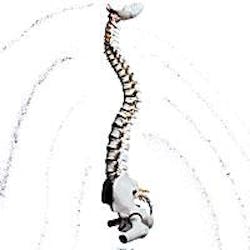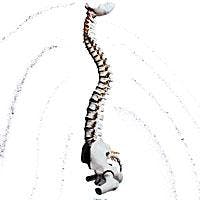Osteoporosis: The periodontal connection
by Cathy Hester-Seckman, RDH
Researchers may soon be able to harness the information gathered in dental exams for use as an early warning of osteoporosis.
Every dental professional occasionally wonders about the link between osteoporosis and oral health. Does the Fosamax your female patients take give them protection from periodontal disease? If an elderly man has bone loss between his maxillary molars, is he at risk for a hip fracture?
Literally millions of people suffer from periodontitis, osteoporosis, or both. Statistics confirm that three-quarters of the population of the United States have some degree of periodontal disease, and that 20 million U.S. citizens - mostly women - suffer from osteoporosis. That figure includes one-third of women over age 65.
Risk factors for developing osteoporosis parallel those for periodontitis: smoking, daily alcohol consumption, family history, lifelong low calcium intake, and advancing age.
Elizabeth Krall, Ph.D., an epidemiologist and associate professor of Boston University's Goldman School of Dental Medicine, has been conducting research into a possible osteoporosis-periodontitis link for some time.
"I first noticed a study of postmenopausal women that looked at the connection between bone density and tooth loss. I started thinking about the reasons people lose teeth, and that led to the next step of trying to demonstrate an association between osteoporosis and periodontitis."
As her study continues, Krall has also begun to look at the osteoporosis-periodontitis relationship in men. "There's a long-term dental longitudinal study at the Boston Veterans Association. It's an observational study of oral health changes with age, the different risk factors we can identify, tooth loss, caries, and major oral problems in men."
The osteoporosis/periodontitis link is the subject of much research in the last few years. "Most of the papers published," says Krall, "suggest there is a link, but we don't know exactly why. No one knows whether both things just happen to occur in older people, or if osteoporosis actually makes someone more susceptible to periodontitis."
Krall, in her research, has been working to tighten the suspected connection. "I'm trying to demonstrate that osteoporosis may somehow affect the course of periodontitis."
One thing that has come out of current research is the idea that a routine dental X-ray may someday be a recognized screening tool for osteoporosis risk. That would require more cooperation between dental health professionals and physicians, an idea applauded by researchers. Both dentists and family physicians are recognizing that the oral cavity is not independent of systemic health.
Researchers at the University of Alabama at Birmingham are conducting a six-year study on bone density that will conclude this year. For the study, bone density seen in dental X-rays is being compared to DXA (dual-energy X-ray absorptiometry) scans of hipbone density in postmenopausal women. It may be possible, say the researchers, to harness the information gathered in dental exams for use as an early warning of osteoporosis.
Adequate calcium and estrogen levels, long recognized as important components in the prevention of osteoporosis, are also being studied as they relate to periodontal disease. Research has found that people with inadequate calcium intake - fewer than 500 mg. daily - suffer from periodontal disease nearly twice as often as those who get enough calcium.One study investigated the influence of estrogen on clinical measurements of periodontal disease. Study subjects with sufficient estrogen levels showed more supragingival plaque but less gingival inflammation. Those who had insufficient estrogen levels showed more bleeding on probing and more attachment loss. The American Dental Association states that estrogen replacement therapy appears to reduce the risk of tooth loss in post-menopausal women.
One surprising discovery is that sodium fluoride, long recognized for building strong teeth, can be a powerful weapon in the fight against osteoporosis. Researchers at the University of Texas Southwestern Medical Center recently completed a 42-month study of osteoporotic women. The study involved the use of sustained-release sodium fluoride combined with calcium citrate and vitamin D to increase spinal bone mass and reduce the risk of vertebral fractures. The researchers learned that sustained release sodium fluoride stimulates osteoblastic activity, while calcium and vitamin D reduce bone resorption. U.S. Food and Drug Administration approval for this treatment is pending.
All current studies seem to clearly point to one idea: Dental health is not independent of total body health, but fully involved with it. As we advise our patients on good oral-health practices and warn them of dangers, dental professionals need to remember that we're not just talking about teeth anymore. Our recommendations apply to every aspect of health. Conversely, the recommendations our patients get from their primary care physicians impact the mouth as much as any other part of the body.
"There's one thing that could come out of these studies," Krall points out. "There are some preventive dietary measures people can take to reduce the risk of osteoporosis - adequate calcium, Vitamin D, and hormone replacement therapy at the time of menopause. We know they work for osteoporosis. There is a biological link (to oral health), so these preventive measures might also have a role in reducing periodontitis."
Cathy Hester-Seckman, RDH, is a frequent contributor based in Calcutta, Ohio.
There are a number of ways to help our bodies build strong and healthy bones, especially during childhood and adolescence. A diet rich in calcium and an active lifestyle are especially important.
Protecting your bones can begin at any age. Here are some ways to ensure healthy bone growth:
- Include at least 800 mg of calcium in your diet each day. This is equivalent to just over a pint of milk, or just over 100 g, of almonds, about 50 g of steamed tofu, or a large bar of chocolate.
- Add calcium-rich, green leafy vegetables such as broccoli, kale, or spring greens to your meals
- Participate in regular weight-bearing exercises like walking, running, or impact sports such as aerobics.
- The elderly - or anyone who is confined indoors for any reason - might consider taking a vitamin C supplement. The best source of this vitamin is sunlight exposure.
information courtesy of the BBC online

